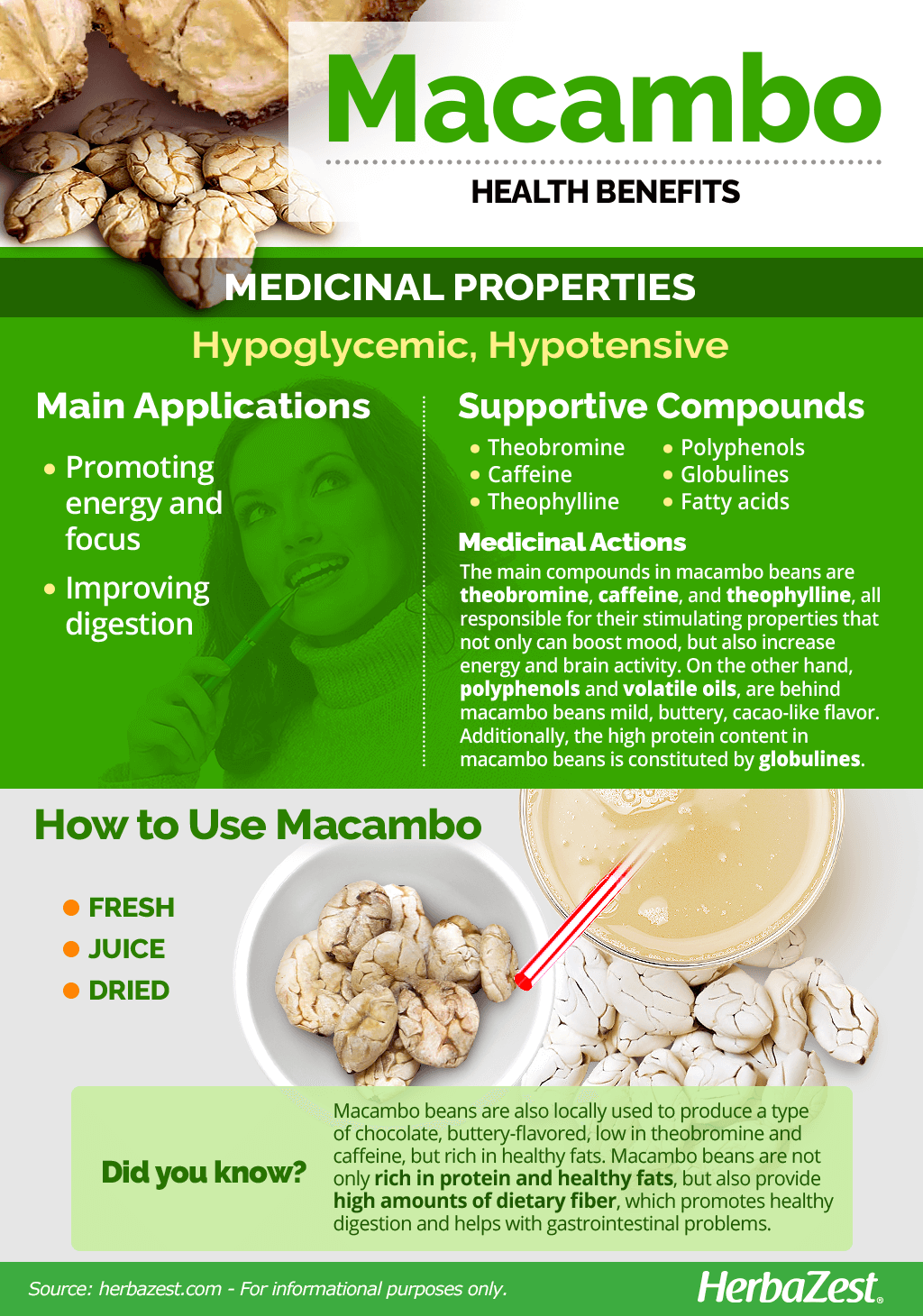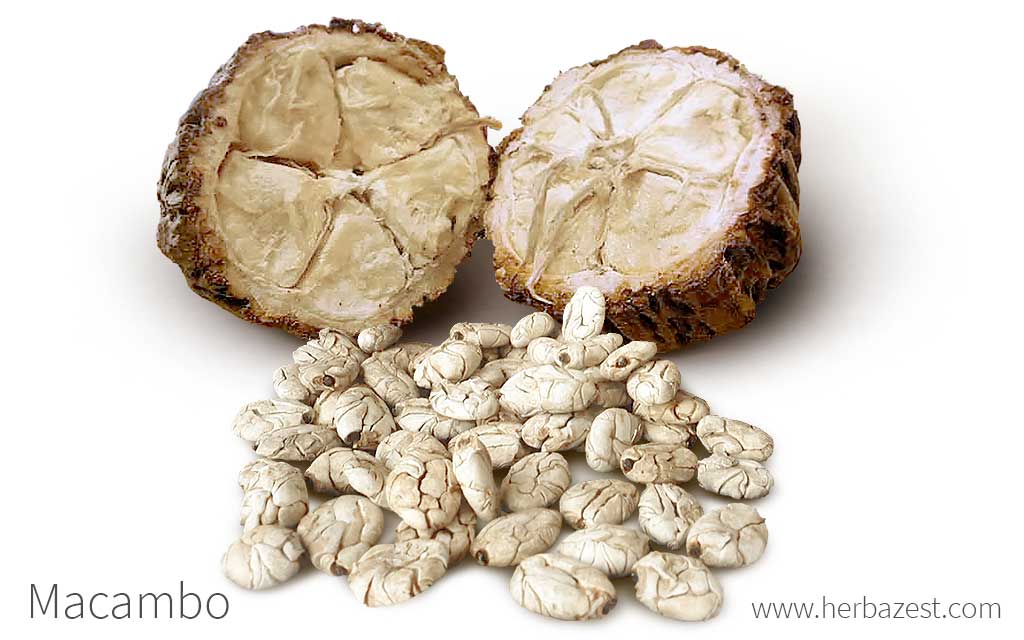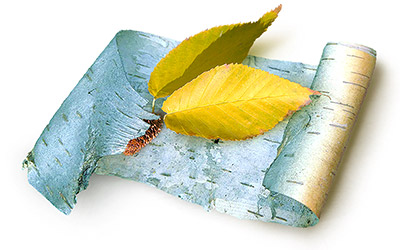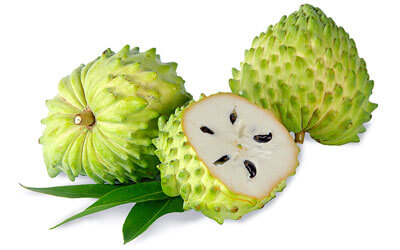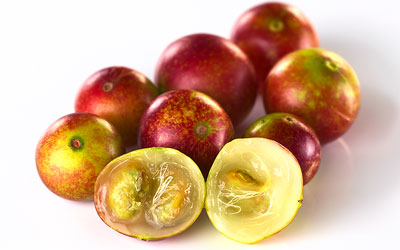Macambo, also known as the mocambo tree, white cacao, and pataxte, is native to Central and South America, particularly abundant in the Amazonian regions of Colombia, Ecuador, and Perú. Macambo beans and pulp have been used for centuries in the same fashion as cacao; however, the unique flavor and health benefits of this Theobroma species have made it a popular novelty in the international market for both human consumption and industrial purposes.
Macambo Medicinal Properties
Macambo pulp and seeds have been widely consumed in tropical areas of Central and South America for centuries; however, very little research has been done to investigate the properties and alleged benefits of macambo, such as:
Promoting energy and focus. Similar to cacao, macambo beans can boost in energy and mood, as well as stimulate brain function.
Improving digestion. Rich in fiber and bioactive compounds, macambo seeds can help facilitate the smooth passage of stools.
Additional benefits of macambo, as promoted online, may include controlling blood sugar levels, reducing the risk of heart disease, and helping with weight loss. Further research is necessary to validate these claims.
How It Works
Like in other Theobroma species, the main compounds in macambo beans are theobromine, caffeine, and theophylline, all responsible for their stimulating properties that can not only boost mood but also increase energy and brain activity.1
Other bioactive components include antioxidant polyphenols and volatile oils, the latter being responsible for macambo beans' mild, cacao-like flavor.2,3
Macambo beans are also high in globulins, a group of proteins that play an important role in liver function and fighting infection, and also have been linked to a lowered cardiovascular risk.4
Other herbs with similar stimulating benefits are cacao,
coffee, ginseng, guarana, rhodiola, and mate, while antioxidant and digestive benefits can be obtained from turmeric, ginger, and cumin.
Side Effects and Cautions
There are no studies or reports about the potential side effects and interactions of macambo beans. However, since macambo is a member of the Theobroma genus, it may cause side effects similar to those of cacao if consumed in excess, even though its content of theobromine and caffeine is significantly lower. These undesirable effects may include allergic skin reactions, migraines, and digestive complaints. Further studies are necessary to determine the safety of macambo.
- Medicinal action Nutritious, Stimulant
- Key constituents Theobromine, caffeine, theophylline, polyphenols, volatile oils, globulines, fatty acids
- Ways to use Food, Juiced, Dried
- Medicinal rating (1) Very minor uses
- Safety ranking Safety undetermined

Macambo Nutrition
There are few studies about the nutritional value of macambo beans; however, a chemical analysis comparing the active compounds of three species of the Theobroma genus - T. cacao (cacao), T. grandiflora (cupuassu), and T. bicolor (macambo) - showed that macambo beans have higher levels of proteins and dietary fiber as well as good amounts of healthy fats.5
Macambo beans are rich in a particular type of proteins, known as globulins, which are not only necessary for muscle building but also for liver function, blood clotting, and immunity. Protein deficiency can lead to loss of bone and muscle mass as well as a weakened immune system. Macambo beans offer a good deal of protein (24g/100g), which can help meet the daily requirements of this essential nutrient.
The amount of dietary fiber found in macambo beans is also significant (31g/100g), helping to lower cholesterol levels, stabilize blood sugar, and regulate bowel movements.
Additionally, macambo beans are a good source of healthy fats, particularly unsaturated fatty acids, which have been shown to improve cardiovascular health by reducing inflammation, controlling cholesterol levels, and stabilizing heart beats.
15 grams of macambo beans provide 80 calories, containing 7% DV of protein, 19%DV of dietary fiber, and 6%DV of healthy fats.
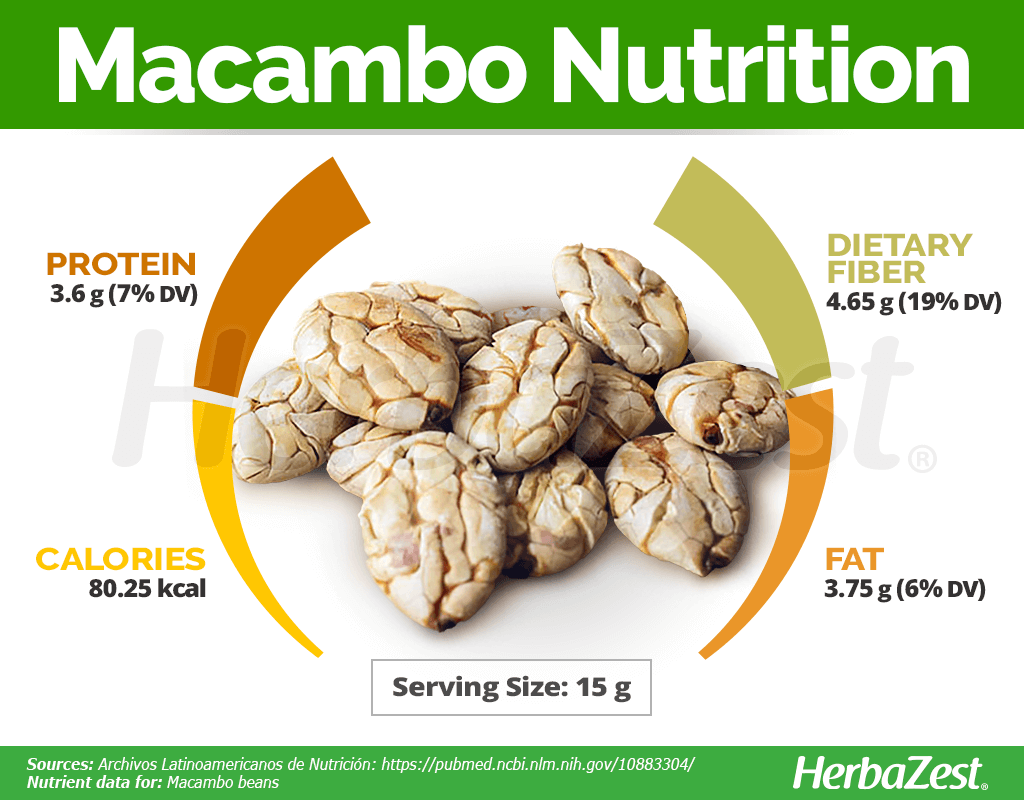
How to Consume Macambo
In the tropical areas where it naturally grows, the macambo fruit is consumed in various ways as part of the local diet. Although macambo beans been utilized in some industrial applications, there are currently no supplemental forms available.
Macambo beans are also locally used to produce a type of chocolate: buttery-flavored, low in theobromine and caffeine, but rich in protein.
Natural Forms
- Fresh. The fresh pulp of macambo fruit has an agreeable flavor, and it is locally consumed alone or added to fruit salads.
Juice. Macambo pulp is commonly consumed as a fresh beverage in tropical regions where this fruit is abundant.
- Paste. A paste obtained from macambo beans is used to make a low-grade chocolate, locally consumed, also showing promise for industrial uses, including enriching commercial chocolates.
- Dried. Once separated from the pulp and dried, macambo beans are popularly eaten as a high-protein snack, or as a crunchy topping for salads.
- Edible parts Fruit, Seed
- Edible uses Beverage, Protein
- Taste Mild
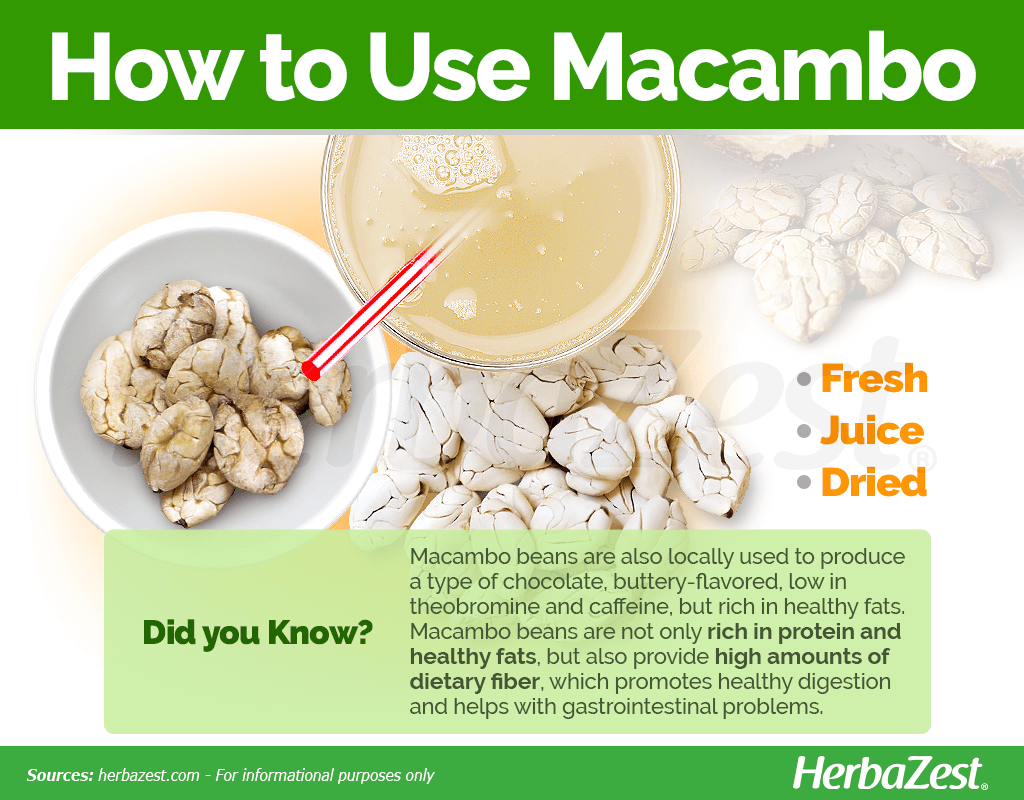
Growing
Macambo, also known as mocambo tree, jaguar tree, pataxte, patashte, and white cacao, is a species that naturally grows in the tropical forests of Central and South America. It requires very specific conditions of soil, weather, and humidity to thrive, which makes its cultivation outside of its native lands particularly difficult .
Growing Guidelines
The macambo tree usually thrives in clay or loamy clay soils, but it is also adapted to poor soils, growing at about 3281 feet (1000 m) above sea level.
It needs temperatures of 77-82°F (25-28°C), and between 900-5000 mm of rainfall annually, to grow in optimal conditions.
In open rainforest areas, when commercially grown as a monoculture, 2.47 acres (1 hectare) can accommodate 270-400 macambo trees. However, in sustainable agroforestry systems managed by local communities, the density is typically lower, with approximately 140 trees per 2.47 acres (1 hectare).
Macambo fruit production starts at about 3 years after planting.
In macambo's native land, the big harvest happens in March and May, with a less significant harvest taking place between July and August.
- Life cycle Perennial
- Harvested parts Seeds, Fruit
- Light requirements Partial shade
- Soil Medium (loam), Clay loam, Peaty
- Growing habitat Tropical rainforests, Amazon rainforest
- Growing time 3 years
Additional Information
Biology of Macambo
The macambo tree is an evergreen that can reach 82-98 feet (25-30 m) high in its natural deep-forest environment, but typically averages 10-26 feet (3-8 m) when cultivated in open areas. It grows in tropical forests of Central and South America, particularly in the Amazonian region of Colombia, Ecuador, and Peru.
Macambo leaves are dark-green, wide, oval-shaped and lanceolated, 0.23 in (5.8 mm) long and 0.05-0.08 in (1.2-2 mm) wide. The flowers, pinkish-white, 0.04-0.08 in (1-2 mm) long, composed by two prominent anthers and 5 lobes, grow attached to the axillary branches. The fruit is greenish-grey, changing color to yellow or yellowish-brown when ripe. It is large and oblong, 3.9-9.8 in (10-25 cm) long, and 3.5-5.9 in (9-15 cm) in diameter, with an average weight of 1-1.5 kg. Each fruit contains about 35 seeds, or beans, which are 0.6-1.2 in (16-30 mm) long, 0.6-1.0 in (14-25 mm) wide, and 0.3-0.5 in (8-13 mm) thick.
Classification
Macambo (Theobroma bicolor) is a member of the Malvaceae family, which comprises around 2,300 species, many of which are flowering plants. Other notable members of this large group, also known as the "mallow family," are baobab (Adansonia digitata), cacao (Theobroma cacao), hibiscus (Hibiscus sabdariffa), and marsh mallow (Althaea officinalis).
Related species and cultivars
The Theobroma genus comprises over 20 identified species; nonetheless, with the most popular ones being cacao (T. cacao), cupui (T. Subincanum), copoazu (T. grandiflorum), and macambo (T. bicolor).
There are no specific varieties of Theobroma bicolor; however, the locals recognize two types of macambo beans: wrinkled and smooth.
The name of macambo genus, Theobroma, can be translated as "Food of the Gods," coming from the Latin words theos, "god," and broma, "food."
Historical Information
All Theobroma species, including macambo, are native of tropical areas of Central and South America, being particularly abundant in the Amazonian regions of Colombia, Ecuador, and Perú. Archeological evidence of ritual and culinary use of different Theobroma species have been found in cultures dating back almost 4,000 years.
Economic Data
Macambo still a novelty in the international market, being commercialized outside of its native lands only since 2014. For this reason, there are no exact numbers accounting for its trade yet. However, Brazil is one of the largest producers and exporters of macambo beans, and other important producers are Peru, Ecuador, and Colombia, all of them providing to important markets, like Canada, USA, EU, and Asia.
Other Uses
Food industry. Due to their high protein content, macambo beans have gained attention from the food industry sector, particularly for their potential use to enrich chocolate and other snacks.
Clean energy and agroforestry. Macambo fruit, pulp, and seeds are being considered as an alternative source for the production of biogas and biofertilizers.
- Other uses Cosmetics, Fuel
Sources
- Archivos Latinoamericanos de Nutricion, Vegetable resources with agroindustrial potential from Guatemala. Chemical characterization of the pulp and of the seeds of Theobroma bicolor, 1999
- BCM Geriatrics, Associations between albumin, globulin, albumin to globulin ratio and muscle mass in adults: results from the national health and nutrition examination survey 2011–2014, 2022
- Food and Fruit-bearing Forest Species - Examples from Latin America, pp. 289-290
- Food Chemistry, Substantial equivalence analysis in fruits from three Theobroma species through chemical composition and protein profiling, 2018
- Food Research International, Comparison of bioactive components and flavor volatiles of diverse cocoa genotypes of Theobroma grandiflorum, Theobroma bicolor, Theobroma subincanum and Theobroma cacao, 2022
- Industrial Crops and Products, Potential of the amazonian exotic fruit for biorefineries: The Theobroma bicolor (Makambo) case, 2016
- Journal of the American Oil Chemists' Society, Composition of the fat extracted from the seeds of theobroma bicolor, 1984
- Medlineplus, Globulin Test, n.d.
- Ministerio de Agricultura del Perú, Instituto Nacional de Innovación Agraria - Macambo (Theobroma bicolor Humb. & Bonpl.)
- Purdue University, FUNCTIONAL PROPERTIES OF SOLUBLE HYDROCOLLOIDS EXTRACTED FROM THEOBROMA BICOLOR (MACAMBO) PROCESSING WASTE AND IN-FIELD PRECOOLING UNITS TO REDUCE PRODUCE WASTE IN THE UNITED STATES, 2023
- SIngapur Government, National Parks, Flora & Fauna Web, Theobroma Bicolor Bonpl.
- Wild Crop Relatives: Genomic and Breeding Resources: Forest Trees, p. 287
Footnotes:
- Scientific Reports. (2024). A revisited history of cacao domestication in pre-Columbian times revealed by archaeogenomic approaches. Retrieved April 29, 2024, from: https://www.ncbi.nlm.nih.gov/pmc/articles/PMC10920634/
- European Journal of Lipid Science and Technology. (2002). Antioxidant activity of macambo (Theobroma bicolor L.) extracts. Retrieved April 29, 2024, from: https://onlinelibrary.wiley.com/doi/abs/10.1002/1438-9312(200205)104:5%3C278::AID-EJLT278%3E3.0.CO;2-K
- Food Research International. (2022). Comparison of bioactive components and flavor volatiles of diverse cocoa genotypes of Theobroma grandiflorum, Theobroma bicolor, Theobroma subincanum and Theobroma cacao. Retrieved April 29, 2024, from: https://pubmed.ncbi.nlm.nih.gov/36192930/
- Food Chemistry. (2018). Substantial equivalence analysis in fruits from three Theobroma species through chemical composition and protein profiling. Retrieved May 2, 2024, from: https://pubmed.ncbi.nlm.nih.gov/28946303/
- Archivos latinoamericanos de nutrición. (1999). Vegetable resources with agroindustrial potential from Guatemala. Chemical characterization of the pulp and of the seeds of Theobroma bicolor. Retrieved May 2, 2024, from: https://pubmed.ncbi.nlm.nih.gov/10883304/
